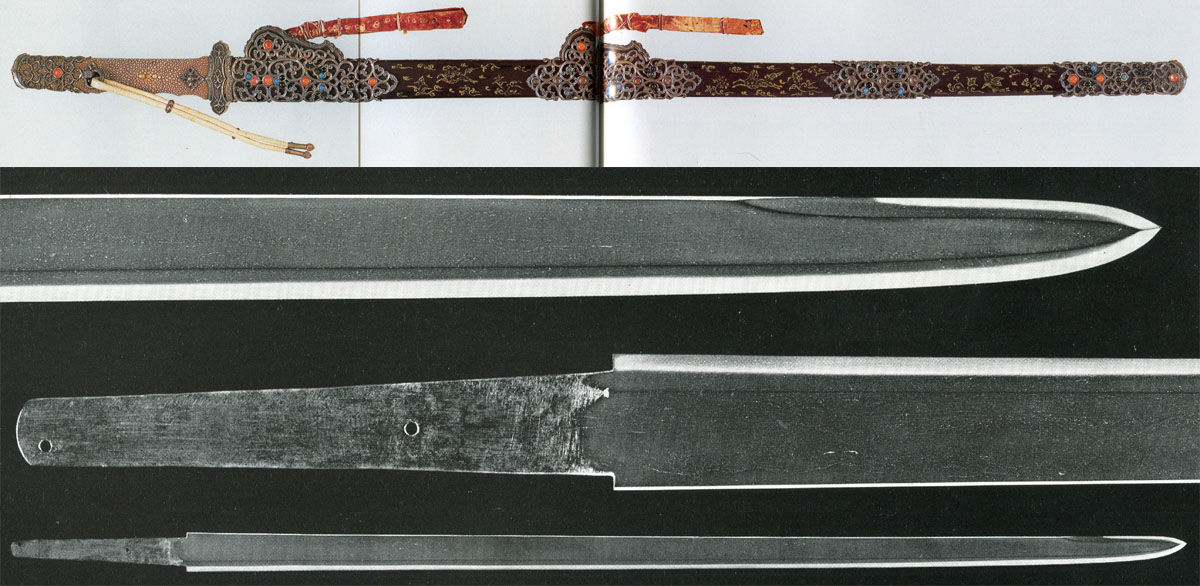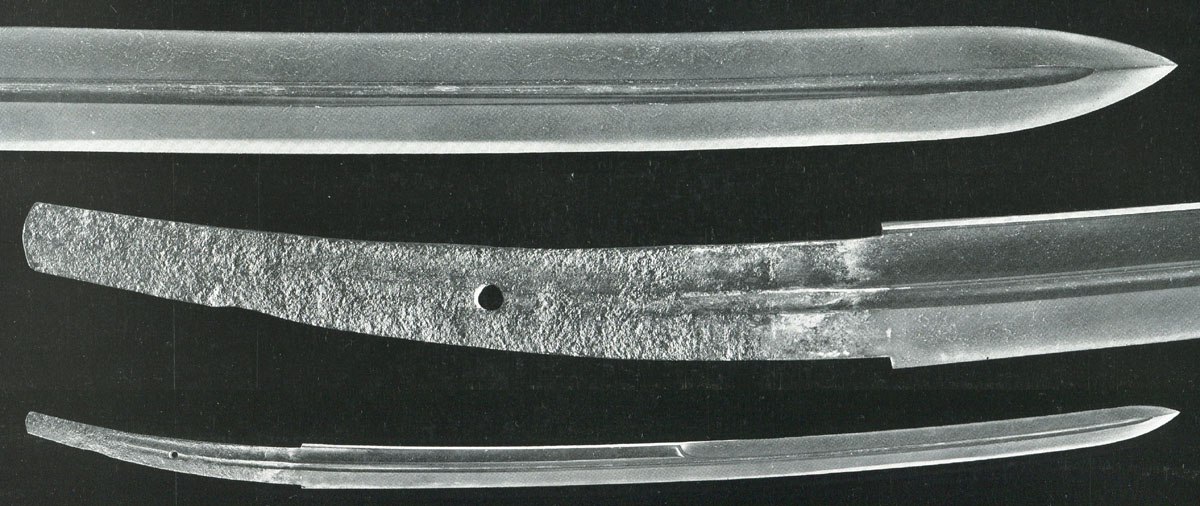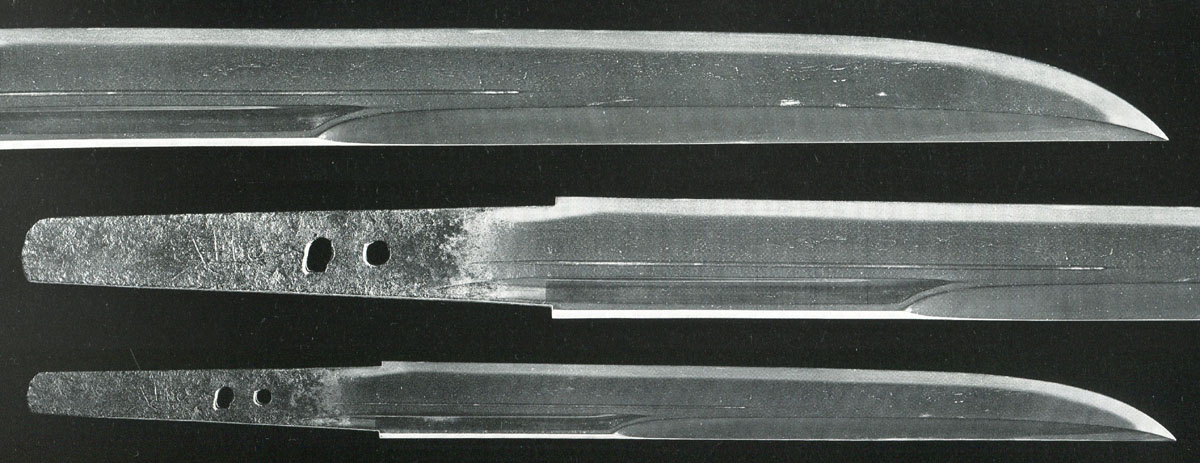(We have received a request from customer to explain about Kissaki-Moroha-zukuri blade.)
1) Before Kissaki-moroha-zukuri blade appeared
The oldest blade style of sword was hira-zukuri in Japan. Then, kiriha-zukuri blade appeared sometime later. They were all straight.
Tachi with hira-zukuri blade (excavated from a grave 7th century) [1]

Tachi blade of prince Shotoku (AD574 - 622), made in China [2]

The signature on the blade says this is made by "Jiaolin" in the mouse year of Chinese zodiac (556 or 616AD).

2) Kissaki-moroha-zukuri blade appeared
Some of the oldest kissaki-moroha-zukuri blades are found in the collection of the emperor Shomu (AD701 - 756). The collection has been kept in Shosoin at Todaiji temple in Nara. The collection has many swords in 8th century, and the condition is very good. Some of them are made in China, and some are made of the imported steel. Probably some are made of the steel produced in Japan. The social system in that age was a copy of China, and so was the swords.
The swords in this age are straight. Intentionally curved sword was not created yet. The kissaki-moroha-zukuri blade in this age is based in kiriha-zukuri style, and the double edged part is not very long, some 10cm or so is double edged. This might be a modern style that came from China, and so is shinogi-zukuri blade. We can't find those styles before.
Samples in the emperor Shomu's collection (8th century)
Chinese sword (Kara-tachi) with kissaki-moroha-zukuri blade [3]

Chinese sword (Kara-tachi) with shinogi-zukuri blade [4]

Warabite-tachi with kissaki-moroha-zukuri blade [5]

3) Kissaki-moroha-zukuri blade based with shinogi-zukuri
At the end of 8th century, the power of Chinese dynasty "Tang" became down, and Japanese government stopped learning China. Then Japan started own social system and culture. In this age, most of long sword is shinogi-zukuri and kiriha-zukuri. Some kissaki-moroha-zukuri style blades also are found in this age.
Tachi of Sakanoue-no-Tamuramaro (9th century) [6]

4) Kogarasu-maru was made out
The period from 9th century to 11th century was a time that Japan was creating its own culture. The style of "Japanese sword" also was created in that period. Generally, the shape of long sword turns to shinogi-zukuri, and the intentional curvature occurred. The base of kissaki-moroha-zukuri also became shinogi-zukuri.
One of the most famous kissaki-moroha-zukuri blade in this period is "Kogarasu-maru". It was a treasure of the clan "Taira", and now belong to the imperial collection.
Tachi "Kogarasu-maru" (10th century) [7]

Tachi in the Kasuga-taisha shrine (10-11th century) [8]

5) Kissaki-moroha-zukuri lost the popurality by samurai
In 12th century, warriors get the political power and control the government. That was a start of samurai age. Kissaki-moroha-zukuri blade in this age is rare, but still exist. According with shinogi-zukuri blade became popular, kissaki-moroha-zukuri blade survived in ceremonial sword by the nobilities.
On the other hand, the kissaki-moroha-zukuri style changed to kanmuri-otoshi style. The big difference between these styles is the shape of point and back edge. Usually, the back edge of kanmuri-otoshi is not very sharp. The style became popular in tanto and naginata.
Tanto made by Ryokai (13th century) [9]

Naginata made by Kagemitsu (14th century) [10]

6) Remembrance of Kogarasu-maru
In 19th century, it was the end of samurai age, kissaki-moroha-zukuri attracted people's eye again. Some famous smiths made such blades. But the boom was not for practical use, it was a fashion to return to glory days of Samurai.
Tanto made by Katsuichi (19th century) [11]

7) Conclusion
Kissaki-moroha-zukuri style in Japan started as a new fashion from Chinese dynasty "Tang". It was used as weapon. During the shinogi-zukuri and curved blade became popular in samurai, kissaki-moroha-zukuri became rare. After the shape lost the popularity by warriors, it kept value in ceremonial sword with its elegant looking. Some samurai still loved the shape. It is flashed back again at the moment of samurai age ending. For sword lovers today, Kogarasu-maru remembers us the story the two biggest samurai clans "Taira" and "Minamoto" fought against each other to grow up their power. It is a nostalgia of the glory days of samurai.
8) Modern age
In 20th century, kissaki-moroha-zukuri blade appeared again as a blade for Army and Navy sabre. It can be found often on parade sabre. It should be called a European style blade, rather than kissaki-moroha-zukuri blade. On the other hand, many blades for combat were still traditional shinogi-zukuri style.
Parade sabre of Japanese Navy (20th century)
9) Sketch of Kogarasu-maru [12]

10) What is the difference between kissaki-moroha-zukuri and kanmuri-otoshi-zukuri?
Of course the shape is different. The shape around tip is the term to distinguish them. But bigger difference is their function. Kanmuri-otoshi blade doesn't have sharp edge on back, while kissaki-moroha blade has sharp edge on back. On kanmuri-otoshi blade, the hamon on back is only near the tip. Then, sharp edge doesn't come on the back. If there is a kanmuri-otoshi-zukuri blade that has hamon all through the thin back, it can call sharp edge on the back. Such blade is very similar to kissaki-moroha-zukuri in its function.
The difference between kanmuri-otoshi-zukuri and kissaki-moroha-zukuri includes another question in the meaning of function. In Japanese swords, double edged long sword is rare. Symmetric double edged long sword does not accord with the method of Japanese blade smithing. The cutting edge of Japanese sword is hard and sharp. On the hardening work on sensitive steel, some curvature occurs naturally. (=> Actual example of YAKI-IRE) In the case of double edged blade, the stress of the hardening work can't be released. When use the blade, same question occurs. The shock of attacking target may be hard to be released to the back on double edged blade, comparing to single edged blade. Kanmuri-otoshi- zukuri may be easier to relies that shock. Therefore, long double edge may be produced only by master smith. Now, let's study the sketch of Kogarasu-maru again.
(For example => Chinese double edged blade, some cracks appear on the hamon.)